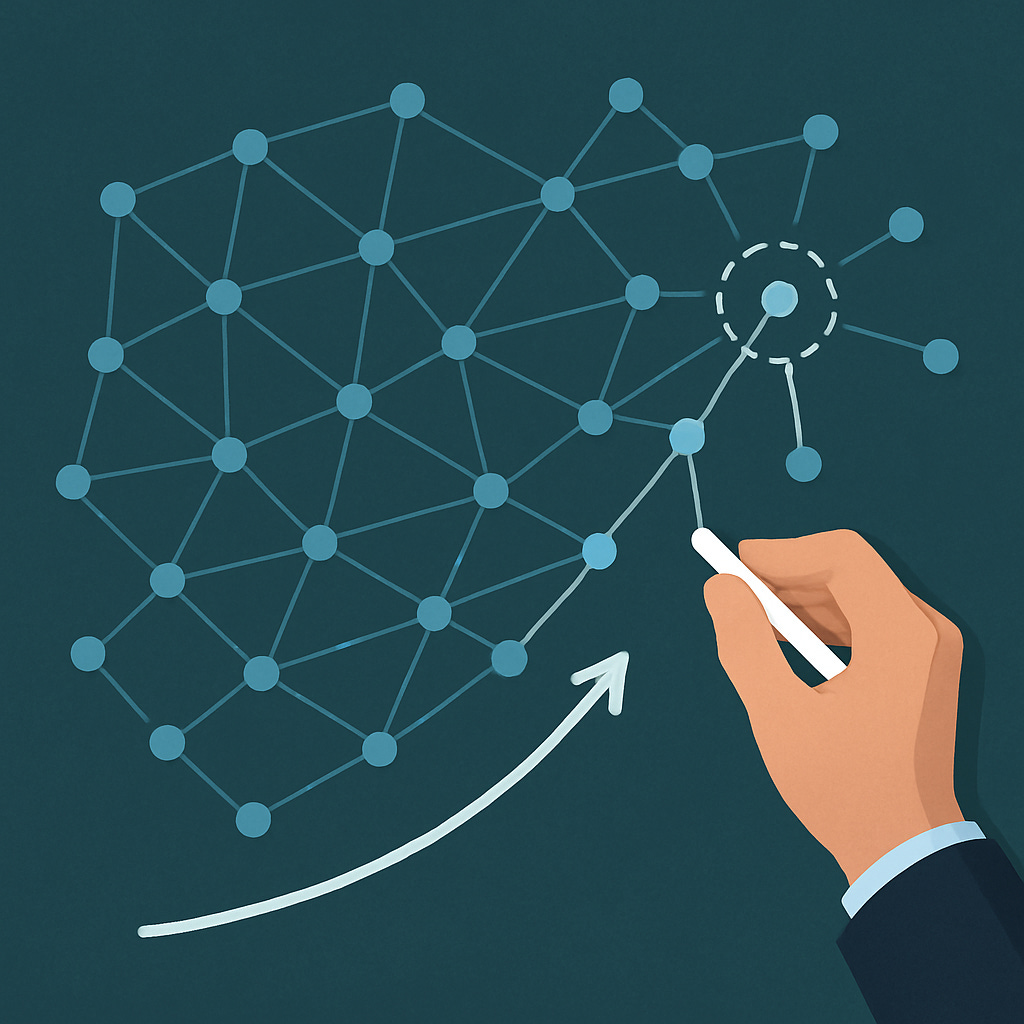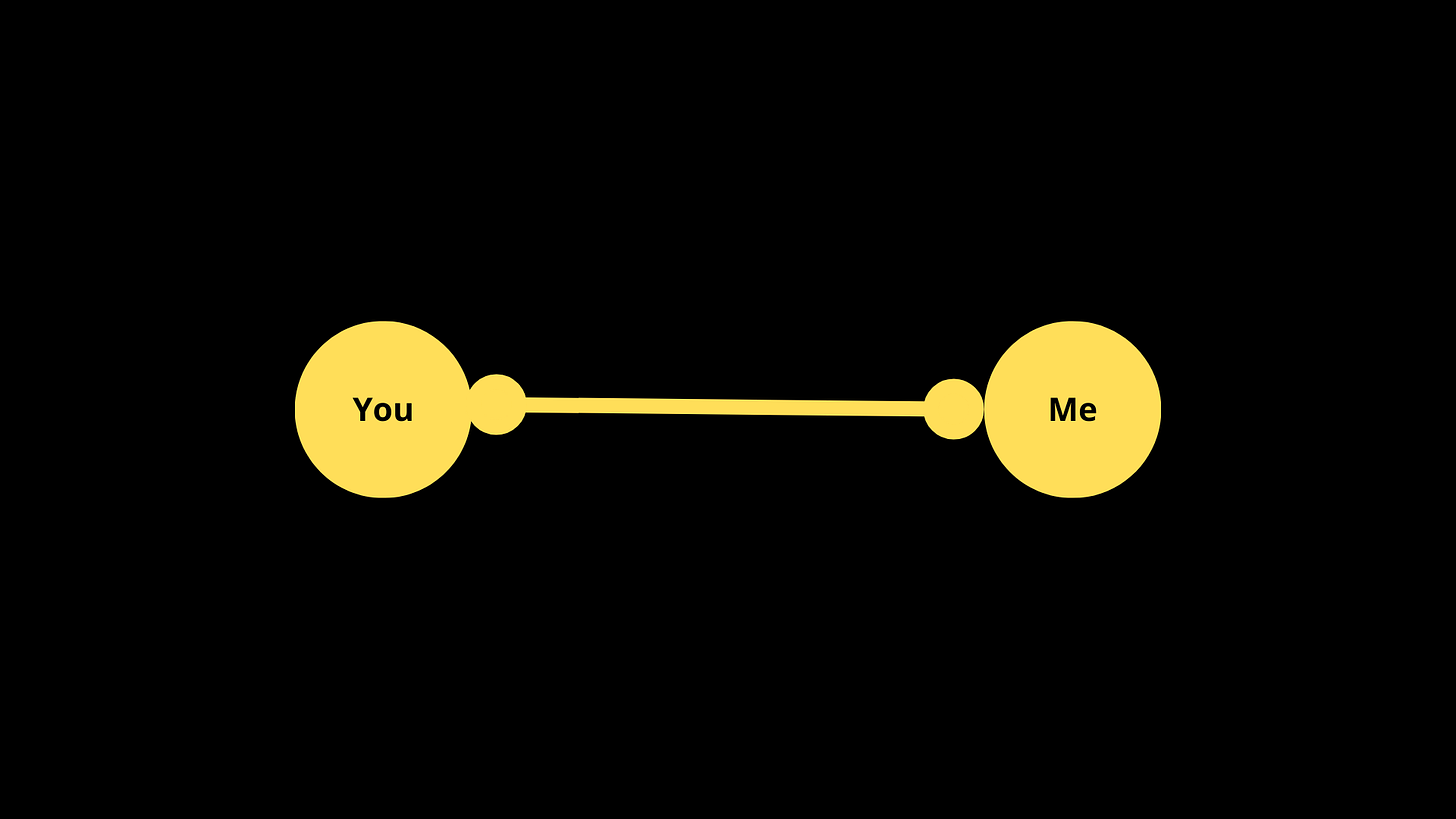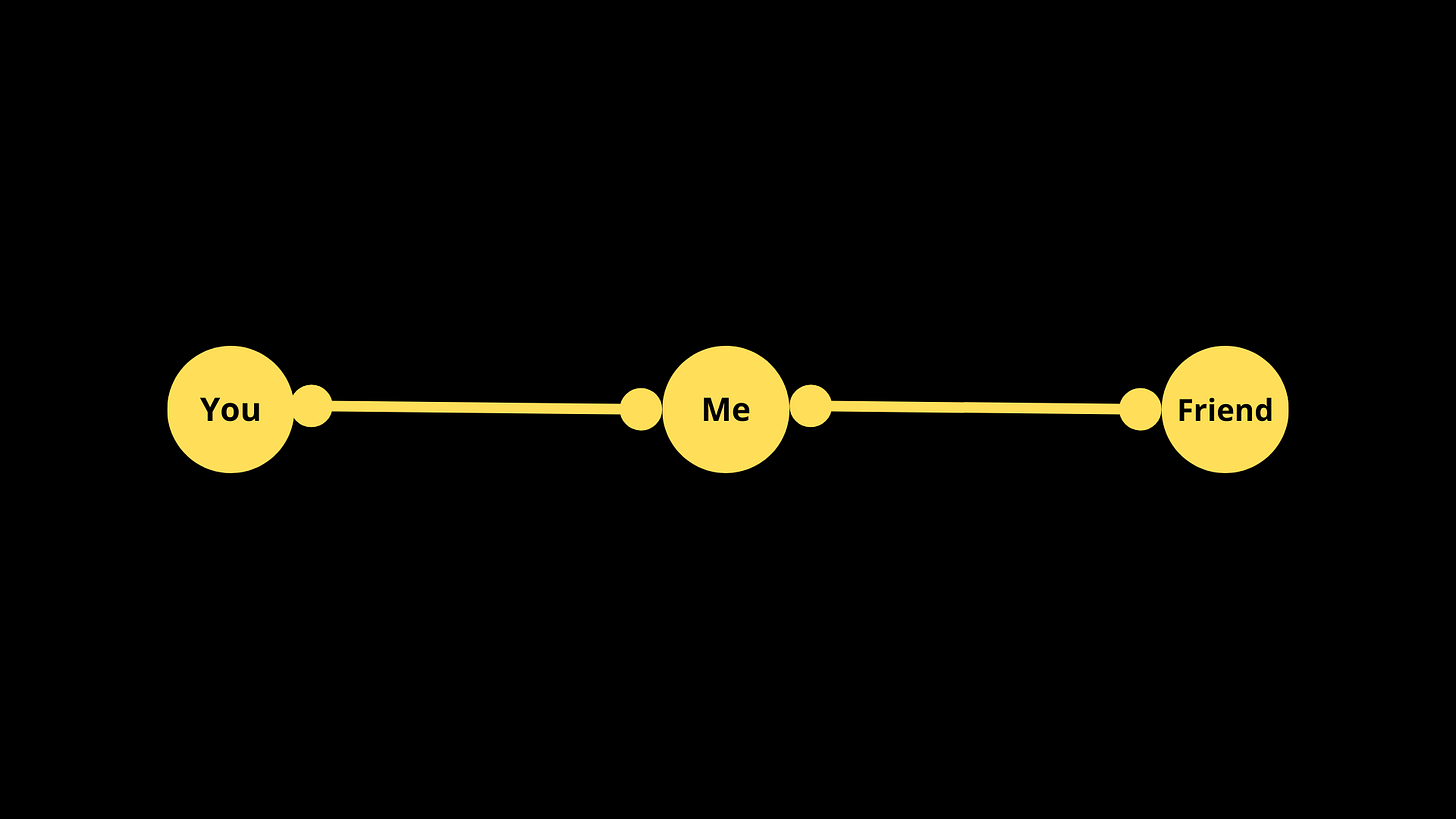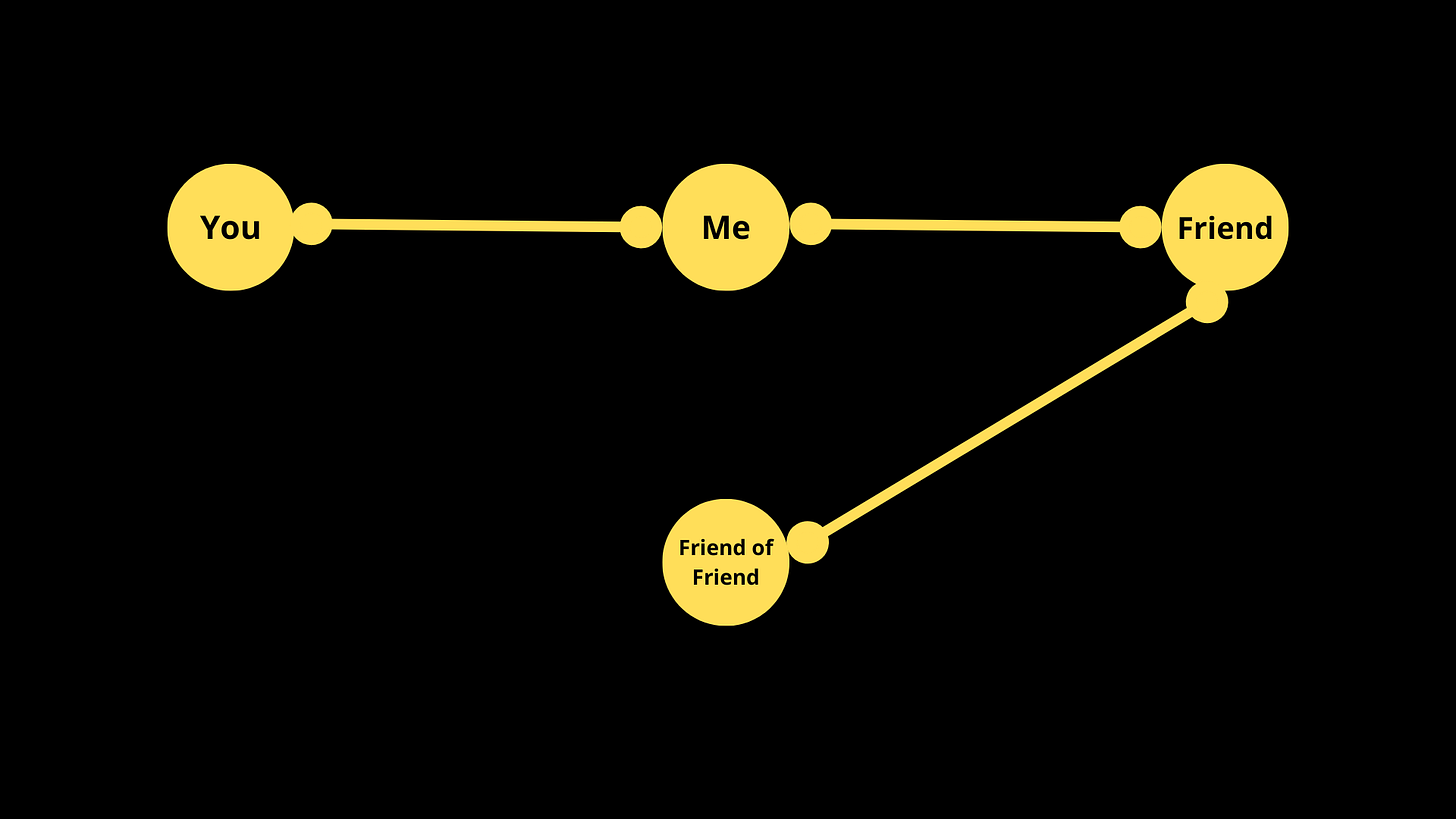How to grow your network
But in the right way ☝🏻
Growing a network is never an easy task.
In today’s post, I’ll try to give you some awareness of how the LinkedIn network works, and share some tips on how to make it grow.
Social networks typically propose either symmetric (e.g., friends) or asymmetric relationships (e.g., followers).
LinkedIn has a hybrid approach:
Here you have both:
Connections (symmetric)
Followers (asymmetric)
Connections work like Facebook’s “friends,” whereas followers are more like those on Instagram.
So how can they co-exist?
Well, typically if you send a connection request, you automatically follow that person.
You can unfollow a connection at any time without removing them. Conversely, if you remove a connection, your follow remains.
Why this difference? How should you leverage it?
The LinkedIn Graph 🦻🏻
Like all social networks, LinkedIn has implemented a networking system. What sets it apart from other platforms is that it is an explicit graph.
A graph is a data structure composed of nodes and edges, where nodes represent user profiles and edges represent relationships between them.
Now it’s pretty evident why relationships can be symmetric or asymmetric, right?
In the special case of symmetric edges, where both arrows point to each other's profiles, we can build an interesting concept: the neighbourhood.
Let’s say I add you as a connection and you accept. I become your neighbour, because in the network graph, there is now a direct path from my profile to yours.
Now imagine I have a friend who didn’t add you. There won’t be a direct link between them and you, but since there’s one with me, there’s still a way to reach your profile via me with 2 jumps.
The same logic can be extended to a friend of my friend who doesn’t know either of us. At that point, 3 jumps would be needed to reach you.
That number is called distance, or degrees of separation.
There’s a famous theory called “Six degrees of separation” formulated in 1929, stating that anyone in the world can be reached in at most six steps.
In recent years, this theory has been revisited, and it turns out that with social networks, the max distance has shortened to about 4.
That’s why on LinkedIn, you’ll find a little number next to each profile, indicating how far they are from you:
1st – 2nd – 3rd – 3rd+
Connections 🤝
Based on what you’ve just read, you now understand that connections are what allow you to reduce your distance from others, helping you move more freely within LinkedIn’s network.
Choosing to connect with someone means you’re declaring a professional proximity, and LinkedIn features are built on this assumption.
Becoming someone’s neighbour means you’re more likely to appear in “People you may know,” for their connections.
Also, recruiters are more likely to discover you when they look at profiles close to yours.
This is an incredible opportunity to position yourself in the ideal area of the professional network — where "ideal" means a place that increases the likelihood of being discovered and added.
As of now, the limit for connections is 30,000 (source).
Followers 👀
Followers, on the other hand, don’t affect your degrees of separation, but they allow you to:
See someone's updates in your feed
Follow their reactions, posts, and activity
This influences how engaged you are on the platform. That’s why it’s important to follow people you’re genuinely interested in. For instance, LinkedIn Top Voices are inspiring individuals who often share high-value content.
The reverse is also true: if someone follows you, your posts can appear in their feed.
There’s currently no known limit for the number of followers you can have.
🤔 “So, how do I grow my network?”
Feels like I can almost hear you ask that 😏.
There are plenty of behaviors and tactics you can adopt, but today we’ll focus on how to strategically use connections and followers, as they are key to your visibility on the platform.
The Strategy
Your strategy should be based on the following pillars:
I will never grind connections just to grow numbers
I will always carefully choose who I add, and who I accept
My connections must be people in my field, or people I know
I will give priority to connecting with people geographically close to me
The biggest temptation is to take a greedy approach and hope for short-term results, watching your follower count rise quickly. But let me tell you — that’s a mistake.
It’s a bit like when you want to gain muscle mass, and you struggle to put on “good fat”. Gaining weight by eating clean is way harder than losing weight, and indeed it’s so easy to fall in the temptation of eating “a lot” just to gain mass.
Growing your network works pretty much the same way.
Every time you add someone, you’re essentially changing the conditions under which the algorithm decides who sees your posts, your profile, etc.
You might’ve heard of the engagement rate — the ratio of reactions a post gets to the number of people who see it.
The algorithm often determines how viral your post should go based on this initial engagement, usually in the first hour.
With that in mind, engagement rate depends mainly on:
The quantity of your network
The quality of your network
Where:
Quantity = how many people you’ve connected with, plus those following you
Quality = how interested those people are in you and your content
If you add random people just to inflate your numbers, you increase the denominator of that ratio — watering down your audience’s interest in you.
In short: you risk significantly lowering your engagement rate.
Now, go re-read those four pillars. They’re simple, but they help you grow without losing control over quality.
Forget the idea of fast results: this is a long game that requires attention and patience. But if you stick with it, organic growth will come.
The Steps
Get quickly above 100 connections
People are more inclined to follow someone who already has followers. If you have very few, it creates a kind of cognitive friction.At the start, LinkedIn displays only your number of connections (not followers), so make that number count.
Start by adding:
Family members
School friends
University mates
People from your hometown
That should easily get you to 200–300 connections.
Reach +500 connections
Start adding everyone you interact with in your professional life:
Peers, managers, directors, even the CEO. Everyone in your company matters here.This is also the stage where it’s okay to add people you don’t know well — if they work at your company, you’re already professionally close.
By monitoring suggested profiles and consistently adding coworkers, especially after a job change, you should reach 500+ connections.
At this point, LinkedIn starts displaying your follower count instead of your connection count.
Keep connecting, but start thinking about content
Eventually, you'll find it harder to discover new people to connect with. That’s your signal to start attracting people to you.Your new dual focus becomes:
Continue creating valuable connections
Start publishing content
Brainstorm ideas:
Write posts
Share professional updates
Document personal projects
Comment on others’ content
Let content drive, use events to connect more
From here on, your growth should be driven more by content than connections.Still, keep an eye out for people to add — especially if you attend:
Conferences
Meetups
Networking events
Repeat as your career progress
This is where most people stop. But if you keep repeating the previous steps, especially as your career evolves, you can easily reach 1,000+ high-quality followers.(And remember — reaching 30k low-quality followers is easy. It’s the quality that counts.)
The take-off
Few make it here. If you create solid content or go viral — and know how to capitalize on it — you can reach 10k followers.The compound interest
Just like compound interest makes rich people richer, the larger your follower base, the easier it gets to grow even more.Consistency, adaptability, and good timing can get you to 50k+ followers, and maybe even earn you a Top Voice badge.
In my opinion, the time needed to go from step 6 to 7 is shorter than the time it takes to go from step 1 to 5.






